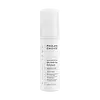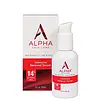What's inside
What's inside
 Key Ingredients
Key Ingredients

 Benefits
Benefits

 Concerns
Concerns

 Ingredients Side-by-side
Ingredients Side-by-side

Water
Skin ConditioningGlycolic Acid
BufferingSodium Hydroxide
BufferingChamomilla Recutita Flower Extract
MaskingAloe Ferox Leaf Juice Extract
Skin ConditioningCamellia Oleifera Leaf Extract
AstringentSodium Hyaluronate
HumectantPanthenol
Skin ConditioningSodium PCA
HumectantPropylene Glycol
HumectantButylene Glycol
HumectantHydroxyethylcellulose
Emulsion StabilisingPolyquaternium-10
Phenoxyethanol
PreservativeSodium Benzoate
MaskingWater
Skin ConditioningGlycolic Acid
BufferingAmmonium Hydroxide
BufferingGlycerin
HumectantPropylene Glycol
HumectantChamomilla Recutita Extract
Skin ConditioningCamellia Sinensis Leaf Extract
AntimicrobialSodium Hyaluronate
HumectantAloe Barbadensis Leaf Juice
Skin ConditioningWheat Germamidopropyldimonium Hydroxypropyl Hydrolyzed Wheat Protein
Cellulose Gum
Emulsion StabilisingDiazolidinyl Urea
PreservativeIodopropynyl Butylcarbamate
PreservativeWater, Glycolic Acid, Ammonium Hydroxide, Glycerin, Propylene Glycol, Chamomilla Recutita Extract, Camellia Sinensis Leaf Extract, Sodium Hyaluronate, Aloe Barbadensis Leaf Juice, Wheat Germamidopropyldimonium Hydroxypropyl Hydrolyzed Wheat Protein, Cellulose Gum, Diazolidinyl Urea, Iodopropynyl Butylcarbamate
Ingredients Explained
These ingredients are found in both products.
Ingredients higher up in an ingredient list are typically present in a larger amount.
Glycolic Acid is arguably the most famous alpha hydroxy acid (AHA) with tons of research backing its benefits.
It is found naturally in sugar cane but the form used in skincare is usually synthetic for purity and stability.
Glycolic acid removes the top layer of dead skin cells to allow newer and fresher ones to emerge.
AHAs work by breaking down the structural “glue” that holds old skin cells in place. When that buildup is gone, your skin can renew itself more efficiently.
Research also shows glycolic acid stimulates collagen production, helping to firm and thicken the skin over time. This is one of its biggest advantages over other AHAs.
Overall, glycolic acid helps with:
Fun fact: Glycolic acid boosts skin hydration by helping it produce molecules that increase hyaluronic acid naturally.
To work best, glycolic acid products should have a pH between 3-4 (that’s where exfoliation is most effective but still gentle on skin).
The pH and concentration of a product are key to its effectiveness:
It is normal to feel a slight stinging sensation when using glycolic acid. This usually fades as your skin adjusts.
Because glycolic acid has the smallest molecular size in the AHA family, it can penetrate deeper, which enhances its effectiveness but also makes it more likely to irritate sensitive skin.
If your skin is very sensitive or prone to rosacea, glycolic acid may be too strong; in that case, try milder options like lactic acid or a PHA instead.
Recent studies suggest glycolic acid might even help protect against UV damage. But don’t skip sunscreen! Freshly exfoliated skin is more sensitive to the sun.
Glycolic acid is a skincare superstar. It smooths, brightens, hydrates, and firms the skin. Unless you’re highly sensitive, it’s well worth adding to your routine.
Read more about some other popular AHA's here:
Learn more about Glycolic AcidPropylene Glycol is an odorless, colorless liquid. As a humectant, it helps skin retain moisture. It also aids in delivering active ingredients.
Another role of this ingredient is preventing a product from melting or freezing. Propylene glycol also adds antimicrobrial properties to a product, elongating product lifespan.
This ingredient is considered an organic alcohol and commonly added into both cosmetics and foods.
Those with sensitive skin or conditions may develop a rash when using this ingredient.
Learn more about Propylene GlycolSodium Hyaluronate is hyaluronic acid's salt form. It is commonly derived from the sodium salt of hyaluronic acid.
Like hyaluronic acid, it is great at holding water and acts as a humectant. This makes it a great skin hydrating ingredient.
Sodium Hyaluronate is naturally occurring in our bodies and is mostly found in eye fluid and joints.
These are some other common types of Hyaluronic Acid:
Learn more about Sodium HyaluronateWater. It's the most common cosmetic ingredient of all. You'll usually see it at the top of ingredient lists, meaning that it makes up the largest part of the product.
So why is it so popular? Water most often acts as a solvent - this means that it helps dissolve other ingredients into the formulation.
You'll also recognize water as that liquid we all need to stay alive. If you see this, drink a glass of water. Stay hydrated!
Learn more about Water